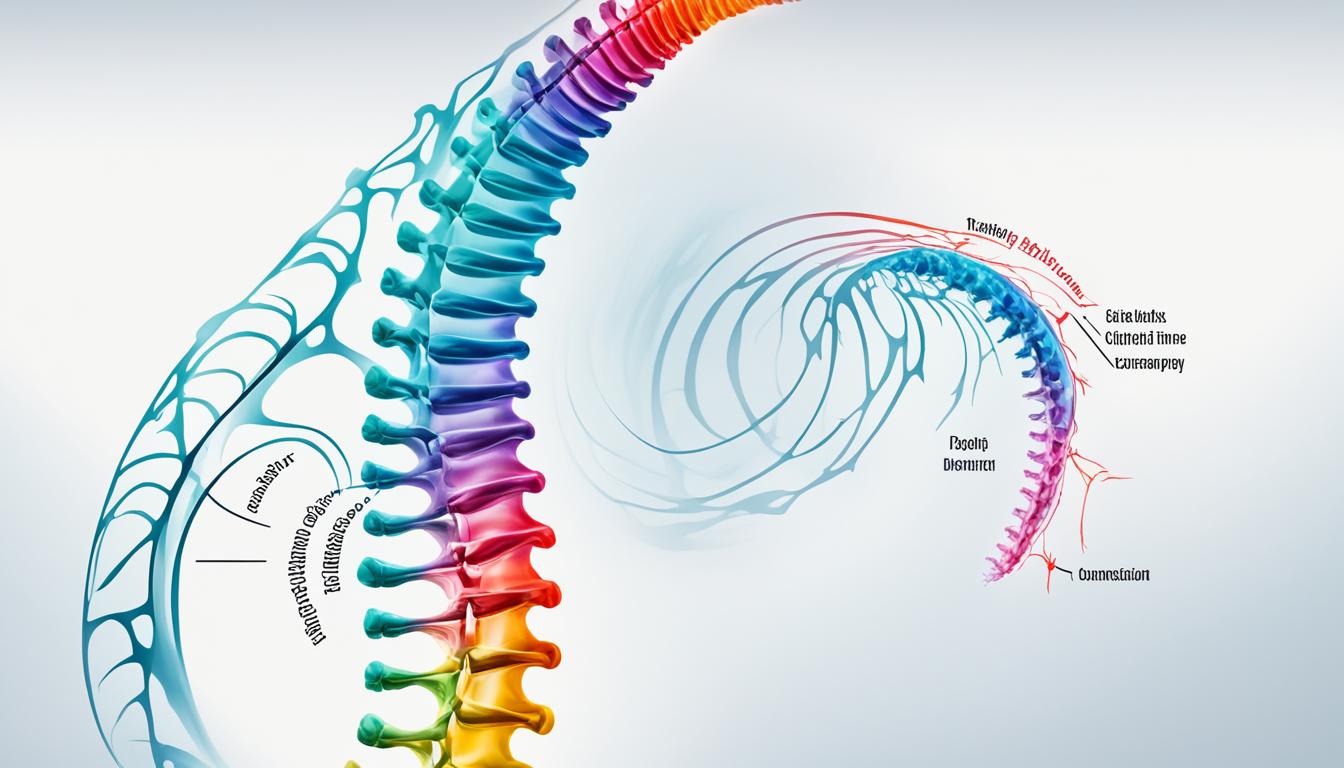Round back disease is also called kyphosis. It makes the spine curve too much. Then, the back looks rounded or hunched. This affects how a person stands and their back health.
Kyphosis has many causes. Some include poor posture, a condition called Scheuermann’s Disease, being born with it, weak bones, and problems with muscles and nerves. Finding it early is very important. This helps treat it better.
There are many ways to treat kyphosis. These range from simple exercises to fix your posture to advanced methods like stem cell therapy. Stem cell therapy has worked well in fixing the curve of the spine and putting bones in their right place.
Key Takeaways:
- Round back disease, or kyphosis, is characterized by an abnormal curvature of the spine.
- It can lead to a rounded or hunched appearance of the back, affecting posture and overall back health.
- Causes of kyphosis include postural round-back, Scheuermann’s Disease, congenital kyphosis, osteoporosis, and kyphosis associated with neuromuscular disorders.
- Early diagnosis is crucial for effective management of the condition.
- Treatment options range from conservative approaches to advanced therapies like stem cell therapy.
Stem Cell Therapy for Round Back Disease
Stem cell therapy shows promise against round back disease, or kyphosis. It depends on mesenchymal stem cells (MSCs). These cells are key in regrowing the spine, especially helping discs heal.
MSCs can come from bone marrow or fat. They have special traits that help straighten the spine and repair discs. They control the immune system, repair tissue, and make new cells. This is very important for fixing the spine.
MSCs help by changing how the immune system works in damaged discs. This reduces swelling and helps the disc stay healthy.
New methods like self-assembling peptide hydrogels and MSC exosomes are promising. They improve how stem cell therapy works. Use of these advanced treatments make stem cell therapy more effective.
Self-assembling peptide hydrogels give MSCs a great place to grow and heal discs. These gels are like the body’s own disc structure. This helps MSCs heal discs better.
MSC-derived exosomes are tiny, cell-to-cell messengers filled with helpful molecules. These exosomes help cells in the disc communicate and heal.
The stem cell field for round back disease is quickly advancing. Researchers are finding better ways to use stem cells for healing.
The Potential of Nanoscale Treatment in Stem Cell Therapy
A big step is using nanoscale treatment in stem cell therapy. MSC exosomes, very small particles, talk between damaged cells. This can repair spinal discs and prevent cell death.
Studies show MSC exosomes can repair discs and save cells. They carry parts that aid healing to damaged areas.
Mixing self-assembling peptide hydrogels with these tiny treatments is even better. The gels help put the exosomes exactly where they’re needed for the best healing.
In short, nanoscale stem cell treatment offers hope for kyphosis. MSCs play a major role in healing back problems. New treatments aim to get better results for patients.
The Future of Round Back Disease Treatment
The world of treating round back disease is changing fast, bringing new hope for patients. People with severe cases might still choose spine surgery, which includes several types. But now, more and more doctors are recommending less invasive methods. These new approaches aim to ease back and spinal pain without a big operation.
Stem cell therapies are one exciting area gaining attention. This includes treatments like BMAC and PRP. These therapies use the body’s own healing powers to repair tissue and reduce pain. Research shows benefits for those suffering from back and spinal pain, offering hope beyond surgery.
Another area seeing progress is biological treatments. Methods using mesenchymal stem cells and new technologies like self-assembling peptide hydrogels aim to help the body regenerate and fix spinal alignment. As we move forward, these innovative treatments could become more common for those with round back disease.
Medical advancements are promising for those with round back disease. The approach to treatment is shifting towards methods that are less invasive and avoid surgery. With a focus on new ways like stem cell and biological treatments, the outlook is hopeful for patients’ recovery and well-being.

